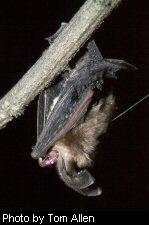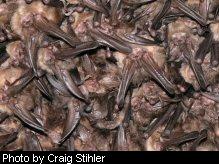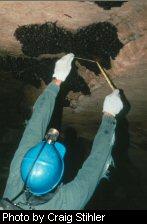

Shedding Light On West Virginia's Cave-Dwelling BatsBy Craig W. Stihler
Eleven species of bats have been observed hibernating in West Virginia caves. The eastern pipistrelle is the most widespread species and is probably found in more caves than any other species. The little brown bat is probably the most abundant species hibernating in the state's caves. This bat may hibernate in a large number of caves, but large concentrations are found in relatively few of them. Caves are also used as roosts by “active” or non-hibernating bats. Several species of bats form maternity colonies in caves where females congregate to rear their young. The Virginia big-eared bat is the only species in West Virginia known to use caves as maternity roosts. Most bats produce just one or two young per year. These pups grow quickly and can fly by the time they are approximately one month old. In addition to being used as maternity colonies, caves are sometimes used as day roosts by male bats throughout the summer. Some caves contain “bachelor” colonies of males, while individual male bats of various species may show up at almost any cave during the summer. Bachelor colonies of little brown bats and Virginia big-eared bats are known in West Virginia. Bats also use caves as night roosts, a place to rest between feeding bouts. After the initial feeding bout early in the night, bats will often roost and digest their food before feeding again. Nursing females may return to their maternity roost to feed their young, but other bats may roost in a shelter near the foraging area. Many caves are the sites of fall swarming activities. At this time numerous bats are present, flying in and out of the cave entrance all night, but few bats may actually be roosting in the cave during the day. Not much is understood about this behavior, but it appears to have strong social implications. This activity may help young bats find suitable hibernation sites, and because autumn is the breeding season , these caves may be places bats go to meet other bats. Observations at one cave in Grant County showed that the cave contained a bachelor colony of Virginia big-eared bats during the summer, but females began to arrive in late summer, presumably after their young were weaned. Bats banded at this site were found hibernating in four different hibernacula . These observations suggest that swarming activities facilitate the “mixing” of bats from different colonies in the vicinity. Although 14 species of bats have been seen in West Virginia, not all species use caves. The hoary bat, the state's largest, roosts in trees and may migrate south before winter. Other species should be considered accidental visitors to the state. The following seven species of bats can be considered typical cave-dwellers in West Virginia. Species AccountsSome of the cave-dwelling bats in West Virginia are rather similar in appearance. Forearm length is the standard measurement of size used to compare species. The shape and size of the tragus (the fleshy projection at the base of the ear that extends in front of the external ear) is also diagnostic for some species. Other characteristics used to identify bat species are the color and luster of the fur, length of the toe hairs, and the presence or absence of a keel on the calcar ( the cartilaginous structure extending from the ankle and supporting the tail membrane). Other clues are behavioral, i.e., does the species form dense clusters while roosting. While some of these characteristics are easily observed, others may be difficult to determine in the field.
Where conditions for hibernation are ideal, little brown bats may congregate in large numbers. Hellhole cave in Pendleton County contains one of the largest aggregations of little brown bats in the eastern United States and houses approximately 125,000 individuals. It is not uncommon for these bats to hang in clusters during hibernation. The bats in the clusters are often arranged in rows giving the appearance of overlapping rows of shingles. Indiana bat ( Myotis sodalis ) In West Virginia, 18 caves in Greenbrier , Mercer, Monroe, Pendleton , Preston, Randolph and Tucker counties serve as Indiana bat hibernacula . The most important hibernaculum is Hellhole in Pendleton County. Approximately 9,000 Indiana bats spend the winter here, making this cave one of the most significant Indiana bat caves in the East. During the summer, females usually form small maternity colonies in trees (usually under loose bark). These bats can travel hundreds of miles between their winter and summer habitats. No maternity colonies have been discovered in West Virginia to date.
Although this species is never found in abundance during winter bat surveys, it is one of the most common bats captured during summer mist net surveys in West Virginia, especially in forested areas. It is also one of the most abundant bats captured at cave entrances during the fall swarming period. More information is needed on the location of its hibernation sites.
Females form maternity colonies where they aggregate to rear their young. These colonies usually seek out the warmest areas of the cave, and colonies may roost in dome pits where the dome probably serves to trap the bats' body heat to create a pocket of warm air. Maternity colonies in West Virginia range from 100 to 1,300 adult females. Each female gives birth to a single young. Male bachelor colonies have also been documented. These bats may visit additional caves during the transition period between summer and winter. Surveys have found theses bats using some caves only in late summer and early autumn. ConservationThreatsDisturbance of bats while in their cave roosts has contributed to the decline of some cave-dwelling species and was one of the reasons the Indiana bat and Virginia big-eared bat were listed as federally endangered species. Other factors that may have contributed to the declines include modification of cave entrances and other changes that affect air flow and alter the microclimate of the cave, construction of barriers at cave entrances excluding bats from caves, loss of cave habitats through quarrying, loss of foraging habitats and summer roost sites, and contamination by pesticides used to control insect pests. In West Virginia, the major causes of population declines in these species appear to have been related to human disturbance of cave roosts. In cases where disturbances have been minimized, many populations are rebounding. Because insectivorous bats have few if any opportunities to feed once they enter hibernation, any factor that causes them to increase their energy expenditures during the hibernation period creates additional stress on these animals. Although all bats naturally awaken periodically during hibernation, their normal fat accumulation prior to entering hibernation is usually sufficient to allow these periods of activity. “Unscheduled” arousals resulting from human disturbance can cause the bats to deplete their fat stores and literally starve before spring returns with an abundance of insects. Biological factors that make the Indiana and Virginia big-eared bats unusually susceptible to disturbance include: 1) these bats often hibernate in large clusters so that one active bat can disturb several neighbors. 2) large numbers of these bats congregate in a small number of caves, and 3) these bats are “light sleepers” and are unusually sensitive to disturbance. Because they provide a wide range of micro-climates, large, complex caves provide the best hibernation sites. These caves are also of interest to spelunkers precisely because they are large and complex. Virginia big-eared bats are also subject to disturbance in their summer roost caves. When disturbed, the adult females may panic and the young may fall to the floor of the cave. Females may not be able to retrieve older, heavier young. Colonies may also abandon good roost sites after being disturbed. Protection
Presently, 21 caves in West Virginia are closed part or all of the year to protect endangered bats. Gates and fences have been constructed at several sites. Hibernation sites are closed to humans from September 1 through mid-May. Virginia big-eared bat maternity caves are closed from April 1 to mid-September. The few caves that are used both in winter and summer are closed all year. DNR biologists count endangered bat populations in hibernacula every other winter, and monitor summer colonies of Virginia big-eared bats each summer using night vision equipment and infra-red lights to count the bats as they leave the cave to forage in the evening. Conservation ResultsReducing disturbance to bats in caves has resulted in significant population increases at some endangered bat colonies in West Virginia. All known Virginia big-eared bat maternity colonies have been monitored annually since 1983. In that year, seven caves housed 3,118 adult bats. These same caves contained 4,500 bats during the 1999 census, an increase of 45 percent. The number of bats in Peacock Cave increased from 160 bats in 1983 to 1,004 individuals in 2002. Setbacks, however, have occurred. The population at one site increased from 650 bats in 1983 to 1,137 bats in 1988 following a year-round closure and fencing of the entrances to the cave system. Between June 1988 and June 1989, vandals broke into the cave and built a fire near the maternity roost site. In 1989, only 286 bats occupied the site. By 2002, the population had increased to 596 individuals, still below the 1983 level. The entrances are now gated. The numbers of hibernating bats have also increased after winter disturbances were curtailed. The number of Indiana bats has increased at a number of caves. These include Big Springs Cave where the number of hibernating bats increased from 78 in 1985 to 199 in 2002 and Hellhole where 3, 330 Indiana bats were found in 1986 compared to 8,566 in 2002. During the same period, the number of Virginia big-eared bats in the cave increased from 2,914 to 5,286 bats. In some caves, however, populations are making a slow come back. Although there were once over 1,000 Indiana bats in Minor Rexrode Cave, the number has increased from two in 1982 to only 35 in 2003. Virginia big-eared bat populations in the same cave, however, have now exceeded known historic levels. There is still much to be learned about the life histories of some species, but great strides are being made. Over 20 years of conservation activities and an increase in public support of bat conservation has enhanced the status of several of the Mountain State's rarest mammals. Craig Stihler is the state's Endangered Species biologist. |
 Caves are important components of the habitats of numerous bat species. Many insectivorous bats living in temperate regions hibernate during the winter when no or little food is available. Caves provide ideal hibernation sites with cool, steady temperatures and high relative humidities . Here, bats are able to reduce their metabolic rates and survive the winter on the fat reserves accumulated prior to entering hibernation. Bats species vary in the habitat requirements they need for hibernation. Some species such as the eastern pipistrelle appear to be “hibernation generalists” and tolerate a wide range of environmental conditions. Other species, such as the federally endangered Indiana bat, require more specific temperature and relative humidity conditions.
Caves are important components of the habitats of numerous bat species. Many insectivorous bats living in temperate regions hibernate during the winter when no or little food is available. Caves provide ideal hibernation sites with cool, steady temperatures and high relative humidities . Here, bats are able to reduce their metabolic rates and survive the winter on the fat reserves accumulated prior to entering hibernation. Bats species vary in the habitat requirements they need for hibernation. Some species such as the eastern pipistrelle appear to be “hibernation generalists” and tolerate a wide range of environmental conditions. Other species, such as the federally endangered Indiana bat, require more specific temperature and relative humidity conditions.  The Virginia big-eared bat is an eastern subspecies of the Townsend's big-eared bat. In West Virginia, it is sometimes confused with the much rarer Rafinesque's big-eared bat. The latter species can be identified by its white rather than buff belly fur.. The large ears and pair of lumps of the nose of this moderate-sized bat are distinctive. Like the endangered Indiana bat, Virginia big-eared bats hibernate in colder portions of caves, form densely-packed clusters, and are easily aroused during the winter. Unlike other bats in the state, the Virginia big-eared bats use caves year round, although they may use a different cave in the winter than in summer.
The Virginia big-eared bat is an eastern subspecies of the Townsend's big-eared bat. In West Virginia, it is sometimes confused with the much rarer Rafinesque's big-eared bat. The latter species can be identified by its white rather than buff belly fur.. The large ears and pair of lumps of the nose of this moderate-sized bat are distinctive. Like the endangered Indiana bat, Virginia big-eared bats hibernate in colder portions of caves, form densely-packed clusters, and are easily aroused during the winter. Unlike other bats in the state, the Virginia big-eared bats use caves year round, although they may use a different cave in the winter than in summer.  To attempt to reverse the decline of endangered bat populations, the U.S. Fish and Wildlife Service and the DNR worked with landowners to limit human access to critical bat caves to periods when the bats were not present. In the early 1980s, cooperative agreements were developed to reduce disturbance at some of the state's most significant bat caves. Gates or fences were constructed at most of these caves to limit access.
To attempt to reverse the decline of endangered bat populations, the U.S. Fish and Wildlife Service and the DNR worked with landowners to limit human access to critical bat caves to periods when the bats were not present. In the early 1980s, cooperative agreements were developed to reduce disturbance at some of the state's most significant bat caves. Gates or fences were constructed at most of these caves to limit access.